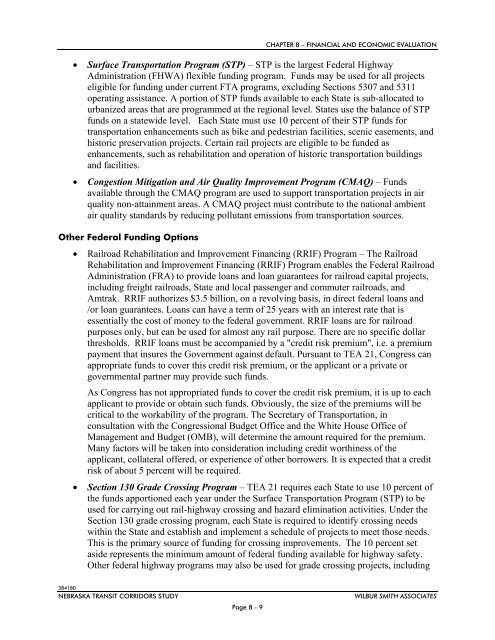NTRAC Final Study - Nebraska Department of Roads - State of ...
NTRAC Final Study - Nebraska Department of Roads - State of ...
NTRAC Final Study - Nebraska Department of Roads - State of ...
Create successful ePaper yourself
Turn your PDF publications into a flip-book with our unique Google optimized e-Paper software.
CHAPTER 8 – FINANCIAL AND ECONOMIC EVALUATION<br />
<br />
<br />
Surface Transportation Program (STP) – STP is the largest Federal Highway<br />
Administration (FHWA) flexible funding program. Funds may be used for all projects<br />
eligible for funding under current FTA programs, excluding Sections 5307 and 5311<br />
operating assistance. A portion <strong>of</strong> STP funds available to each <strong>State</strong> is sub-allocated to<br />
urbanized areas that are programmed at the regional level. <strong>State</strong>s use the balance <strong>of</strong> STP<br />
funds on a statewide level. Each <strong>State</strong> must use 10 percent <strong>of</strong> their STP funds for<br />
transportation enhancements such as bike and pedestrian facilities, scenic easements, and<br />
historic preservation projects. Certain rail projects are eligible to be funded as<br />
enhancements, such as rehabilitation and operation <strong>of</strong> historic transportation buildings<br />
and facilities.<br />
Congestion Mitigation and Air Quality Improvement Program (CMAQ) – Funds<br />
available through the CMAQ program are used to support transportation projects in air<br />
quality non-attainment areas. A CMAQ project must contribute to the national ambient<br />
air quality standards by reducing pollutant emissions from transportation sources.<br />
Other Federal Funding Options<br />
<br />
<br />
Railroad Rehabilitation and Improvement Financing (RRIF) Program – The Railroad<br />
Rehabilitation and Improvement Financing (RRIF) Program enables the Federal Railroad<br />
Administration (FRA) to provide loans and loan guarantees for railroad capital projects,<br />
including freight railroads, <strong>State</strong> and local passenger and commuter railroads, and<br />
Amtrak. RRIF authorizes $3.5 billion, on a revolving basis, in direct federal loans and<br />
/or loan guarantees. Loans can have a term <strong>of</strong> 25 years with an interest rate that is<br />
essentially the cost <strong>of</strong> money to the federal government. RRIF loans are for railroad<br />
purposes only, but can be used for almost any rail purpose. There are no specific dollar<br />
thresholds. RRIF loans must be accompanied by a "credit risk premium", i.e. a premium<br />
payment that insures the Government against default. Pursuant to TEA 21, Congress can<br />
appropriate funds to cover this credit risk premium, or the applicant or a private or<br />
governmental partner may provide such funds.<br />
As Congress has not appropriated funds to cover the credit risk premium, it is up to each<br />
applicant to provide or obtain such funds. Obviously, the size <strong>of</strong> the premiums will be<br />
critical to the workability <strong>of</strong> the program. The Secretary <strong>of</strong> Transportation, in<br />
consultation with the Congressional Budget Office and the White House Office <strong>of</strong><br />
Management and Budget (OMB), will determine the amount required for the premium.<br />
Many factors will be taken into consideration including credit worthiness <strong>of</strong> the<br />
applicant, collateral <strong>of</strong>fered, or experience <strong>of</strong> other borrowers. It is expected that a credit<br />
risk <strong>of</strong> about 5 percent will be required.<br />
Section 130 Grade Crossing Program – TEA 21 requires each <strong>State</strong> to use 10 percent <strong>of</strong><br />
the funds apportioned each year under the Surface Transportation Program (STP) to be<br />
used for carrying out rail-highway crossing and hazard elimination activities. Under the<br />
Section 130 grade crossing program, each <strong>State</strong> is required to identify crossing needs<br />
within the <strong>State</strong> and establish and implement a schedule <strong>of</strong> projects to meet those needs.<br />
This is the primary source <strong>of</strong> funding for crossing improvements. The 10 percent set<br />
aside represents the minimum amount <strong>of</strong> federal funding available for highway safety.<br />
Other federal highway programs may also be used for grade crossing projects, including<br />
384180<br />
NEBRASKA TRANSIT CORRIDORS STUDY<br />
Page 8 - 9<br />
WILBUR SMITH ASSOCIATES

















